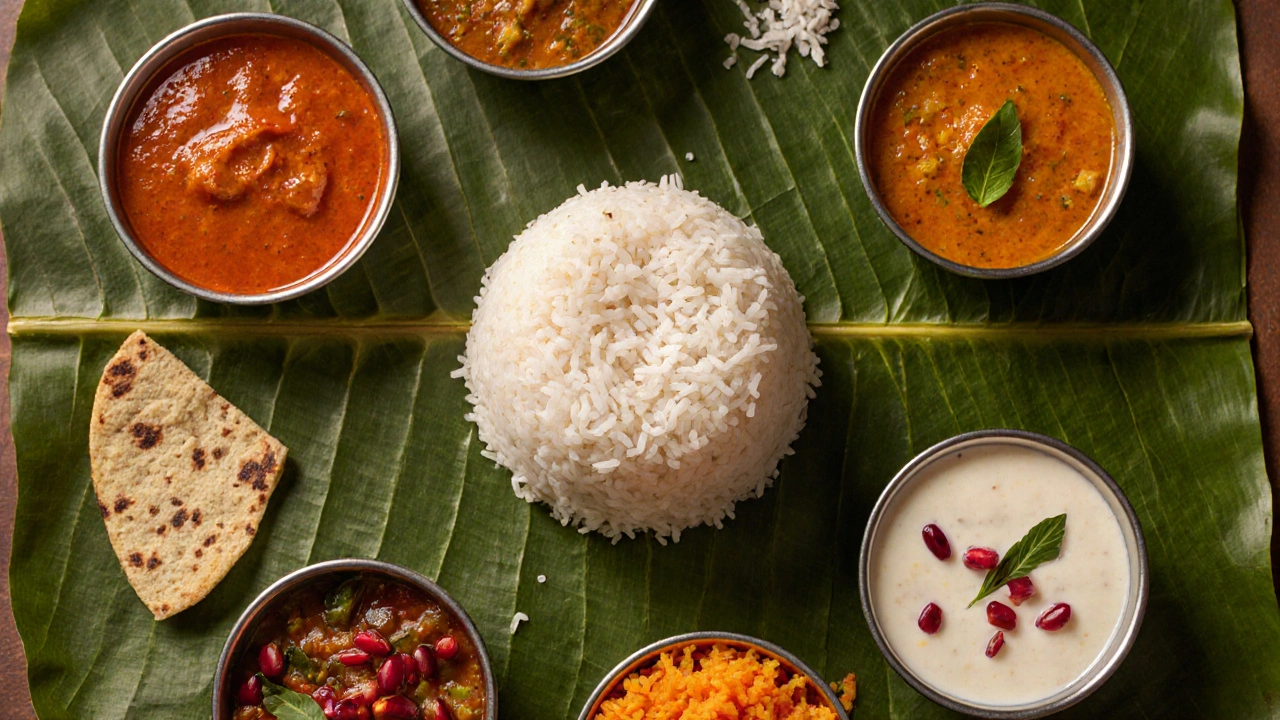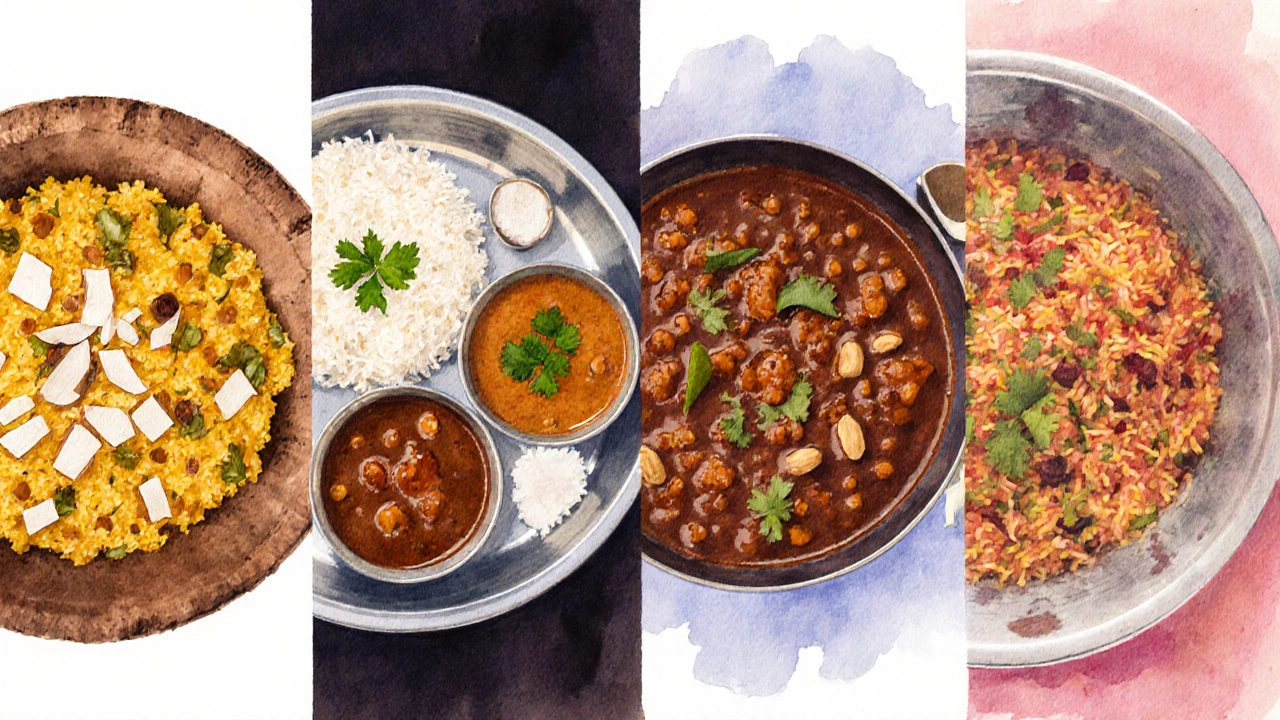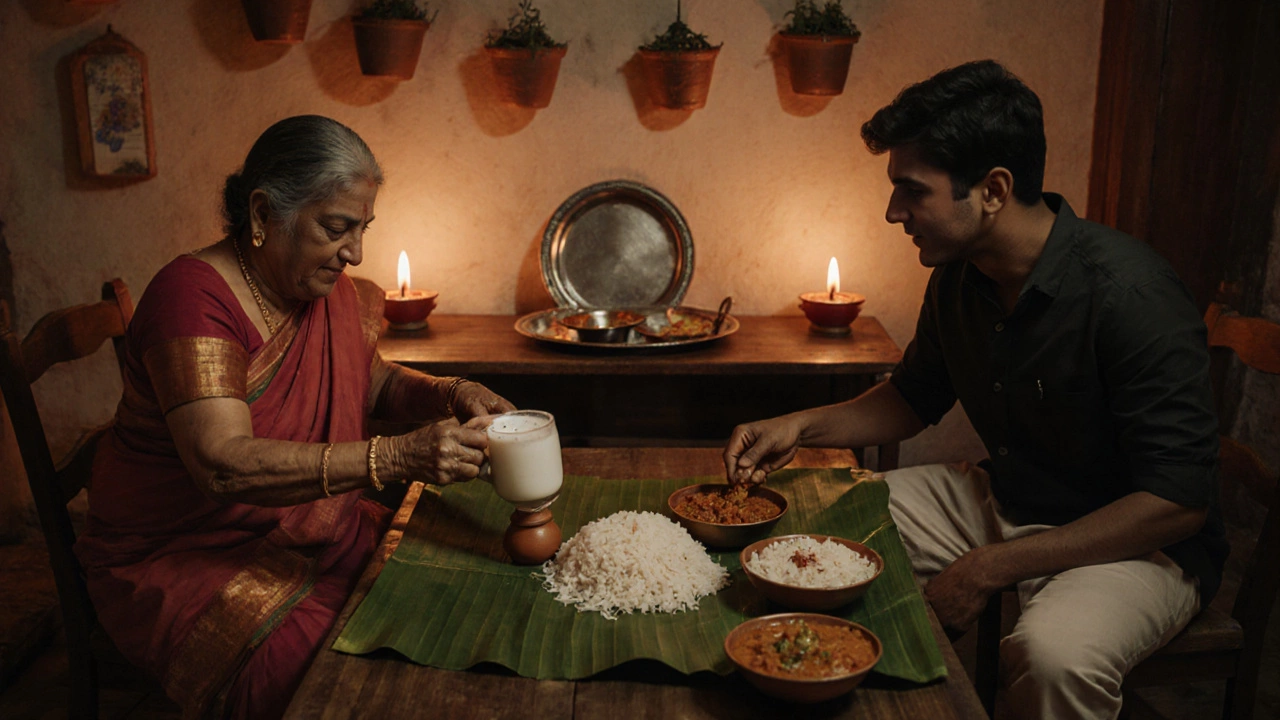Typical South Indian Lunch: Foods, Flavors & How to Enjoy

South Indian Regional Flavor Selector
Select a South Indian State
Tamil Nadu
Kerala
Karnataka
Andhra Pradesh
Signature Dishes & Flavor Profile
Select a state to see traditional dishes and flavor characteristics.
Planning a food stop in the south of India? You’ll soon discover that a South Indian lunch is more than a meal-it’s a cultural experience packed with colors, textures, and aromas that tell the story of the region. Below we break down what you’ll find on a traditional plate, how it varies across states, and practical tips to enjoy it like a local.
What’s on the Plate?
When you sit down for a classic South Indian lunch, the centerpiece is always steamed rice a short‑grain, fluffy staple that acts as the canvas for flavorful gravies and sides. Around the rice you’ll typically see a rotating lineup of accompaniments:
- Sambar a hearty lentil stew spiced with tamarind, mustard seeds, and a medley of vegetables like drumsticks, carrots, and pumpkin
- Rasam a thin, tangy soup based on tomato, tamarind and pepper, often served as a palate cleanser
- Poriyal stir‑fried vegetables (usually cabbage, beans or carrot) tossed with mustard seeds, curry leaves and grated coconut
- Coconut chutney a creamy blend of grated coconut, green chilies, and tempered spices
- Papadam thin, crispy lentil wafers that add a crunchy contrast
- Pickle spicy fruit or vegetable preserves - mango, lime or ginger - that deliver a punch of flavor
- Curd rice cool, soothing rice mixed with yogurt, tempered with mustard seeds and garnished with pomegranate seeds
Many meals finish with a small sweet, such as payasam a milky rice or vermicelli pudding flavored with cardamom, nuts and raisins. The entire spread is meant to balance heat, sourness, sweetness, and texture.
Regional Flavors: Tamil Nadu, Kerala, Karnataka & Andhra Pradesh
Although the core components stay consistent, each state puts its own spin on the lunch.
- Tamil Nadu favors a dry vegetable side called kootu a semi‑dry lentil‑vegetable mash seasoned with coconut and cumin and a richer sambar with tamarind.
- Kerala leans heavily on coconut, serving dishes like avial a mixed vegetable stew cooked with coconut, cumin and yogurt. The staple often switches from plain rice to parboiled rice which has a firmer grain suitable for absorbing coconut‑based gravies.
- Karnataka introduces bisi bele bath a one‑pot rice‑lentil dish seasoned with a special spice blend called bisi bele and often serves a sweeter version of rasam known as tamarind rasam.
- Andhra Pradesh is famous for fiery pappu a lentil curry spiked with red chilies, mustard seeds and curry leaves and a side of pulihora tamarind rice cooked with peanuts and spices.
These nuances give you a reason to try lunch in multiple cities - each version feels both familiar and new.
How South Indians Eat: Etiquette and Experience
Most traditional lunches are served on a banana leaf large, flexible leaf that doubles as a clean, biodegradable plate. The leaf is placed with the tip pointing to the left, signaling the direction for the main rice portion. Food is taken with the right hand; the left hand is considered unclean for eating. This practice stems from ancient Ayurvedic ideas about hygiene.
Meals typically start with a sip of buttermilk a light, salted yogurt drink that aids digestion or a small cup of hot water. Eating is a leisurely affair, often lasting an hour or more, especially on weekends when families gather.
When dining in a restaurant, you’ll notice a “thali” - a round metal platter that holds each component in separate small bowls. The layout follows a visual hierarchy: rice at the center, sambar on the side, then dry items, followed by chutneys and pickles. This arrangement helps you move from milder to spicier flavors.

Typical South Indian Lunch vs. Other Indian Lunches
| Aspect | South Indian Lunch | North Indian Lunch |
|---|---|---|
| Staple | Steamed rice or parboiled rice | Wheat‑based roti, paratha or naan |
| Main gravies | Sambar, rasam, coconut‑based curries | Dal, paneer tikka, gravies with cream or tomato base |
| Accompaniments | Poriyal, papadam, pickles, curd rice | Raita, salad, achar (pickle), papad |
| Spice profile | Mustard seeds, curry leaves, tamarind, coconut | Garlic, ginger, ghee, garam masala, cumin |
| Eating style | Banana leaf or metal thali, hand‑eaten | d>Plate with cutlery, fork and spoon common|
| Typical sweet | Payasam (rice or vermicelli pudding) | Gulab jamun, kheer, halwa |
Understanding these contrasts helps you decide what to order when traveling across the country. If you’re craving a lighter, tangier palate, the South Indian lunch wins hands‑down.
Tips for Travelers: Ordering, Dietary Concerns & Budget
- Ask for “vegetarian thali” if you don’t eat meat - most places automatically serve a plant‑based version.
- Gluten‑free? Stick to rice‑based plates; wheat roti is rare in the south.
- Spice level can surprise visitors. If you prefer milder, say “mild” or “less spicy”.
- Street‑food stalls often serve lunch on banana leaves for just a few rupees. Look for clean, busy stalls with a steady line - that’s a good sign of quality.
- Tip: Pair the meal with a glass of freshly squeezed mango juice or coconut water to balance the heat.

Sample Lunch Menu: From Breakfast to Dessert
Here’s a typical order you might place at a mid‑range restaurant in Chennai:
- Start with a bowl of rasam and a side of coconut chutney.
- Main course: a heaping serving of steamed rice, ladled sambar, a small portion of avial, and a few crisp papadam.
- Add a side of mango or lime pickle for a zing.
- Finish with a bowl of payasam made from rice, milk, jaggery and cardamom.
Even if you swap a few items, the essence stays the same - a comforting rice base surrounded by flavorful, nutritious sides.
Common Mistakes to Avoid
- Don’t overwhelm the plate with too many curry sauces; the balance is key.
- Avoid mixing sweet dessert directly into the rice; it can dilute flavors.
- Never use the left hand for eating; locals may view it as disrespectful.
- Skipping the pickles means missing out on essential acidity that cuts through the richness.
Keeping these pointers in mind ensures you respect the culinary tradition while enjoying every bite.
Frequently Asked Questions
What is the most common protein in a South Indian lunch?
Most traditional vegetarian lunches rely on lentils (dal or pappu) as the protein source. If you choose a non‑vegetarian option, you’ll often see fish or chicken cooked in coconut‑based sauce.
Is it okay to eat with a fork?
In most local eateries, eating with your right hand is the norm. Using a fork isn’t wrong, but it may draw curious looks.
Can I find a South Indian lunch in major cities outside India?
Yes - cities like Singapore, Dubai and London host authentic South Indian restaurants that serve a full thali lunch.
How spicy is a typical South Indian lunch?
Spice levels vary by region. Kerala and Andhra Pradesh lean hotter, while Tamil Nadu can be milder. Always ask for “less spicy” if you’re not used to heat.
What drinks complement the lunch?
Traditional options include plain water, buttermilk, tender coconut water, or a glass of fresh fruit juice like mango or guava.